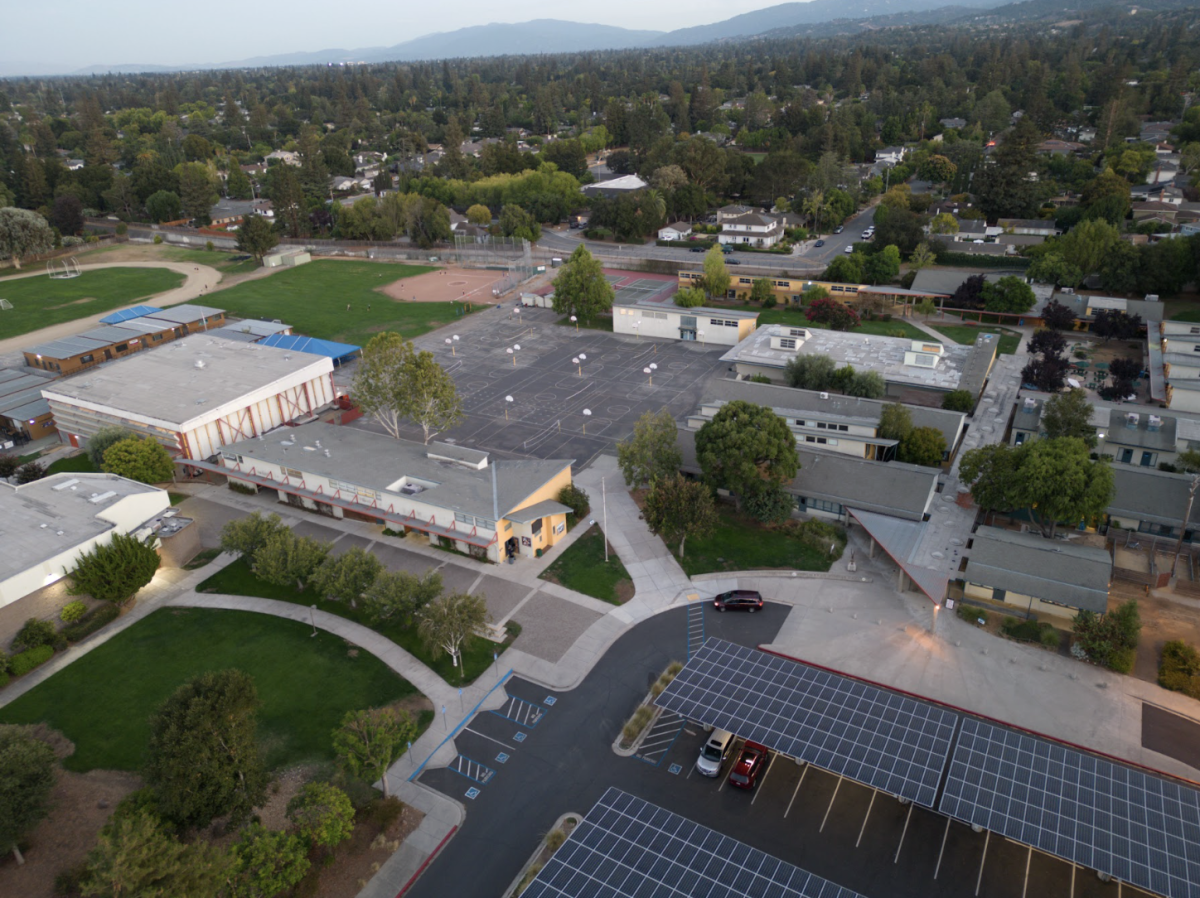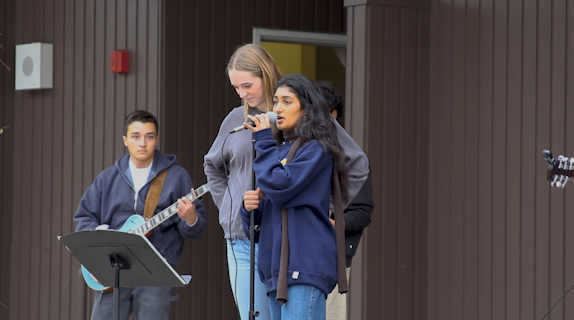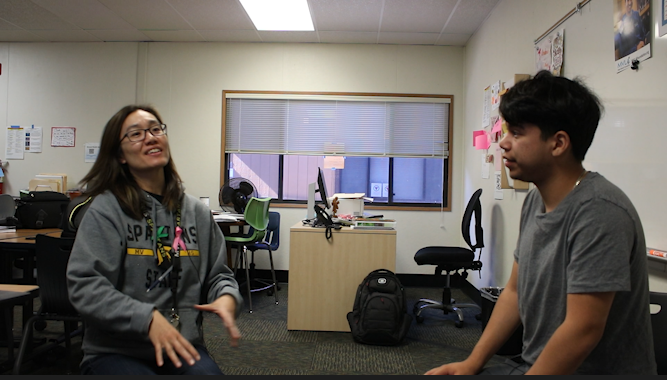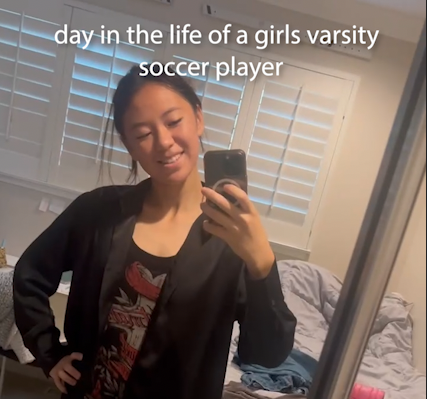Twelve years after consolidation, ELD program returns to Los Altos High School
Apr 20, 2022
Pedro Alcazar, sophomore and English Language Development Commissioner at MVHS, said that the main issue ELD students at MVHS face is transportation.
Some students have to take two or three buses to get to school, meaning that they have to be at the bus stop as early as 6:30 a.m., said Alma Ruelas, bilingual liaison at MVHS.
“Sometimes it’s raining, sometimes it’s very cold, and sometimes they don’t have the money [to take all those buses],” Ruelas said.
Overview
This is the result of the district’s ELD program shifting to a single, centralized program at MVHS in 2009, which increased commute time for many students.
“It’s ridiculous to make kids take two, sometimes three buses to get to another place, just for the convenience of the district,” said MVHS English teacher Hector Pérez.
Alcazar said that transportation is not the only issue; with LAHS lacking a program, students can feel unwelcome at the school.
“From personal experience, not knowing the language is really exhausting,” said Alcazar, who lived in Mexico for ten years. “You can’t communicate with teachers, you struggle with finding friends, and if you need help on homework, it can be really hard.”
Currently, students who live closer to Los Altos High School must attend MVHS in order to continue learning English and taking Specially Designed Academic Instruction in English (SDAIE) classes. There are roughly 300 ELD students across the district, said Teri Faught, Associate Superintendent of Educational Services.
But because of community concern, transportation issues, and an increased ELD student population, the ELD program will be reopening at LAHS for the 2022-23 school year after 12 years of consolidation, Faught said.
Faught said the MVLA district has recently been looking into solving these community concerns in order to benefit ELD students.
“There was enough parent concern, student concern, and even staff concern that it was not equitable for those students to go so far,” said Perla Pasallo, director of student services and equity. “Other students don’t have to go as far and don’t have that stress in their life.”
In March 2021, the Latino Parent Outreach Leadership Team wrote a letter to the district calling for various changes in order to make the district more equitable. One of these changes was to establish the ELD program at LAHS again, Ruelas said.
For the 2022-23 school year, both schools will have classes for ELD levels 1 to 4 and other content classes, like SDAIE, for extra support. The total cost of classes, instructional materials, textbooks, and hiring instructional aides will be around $320,000. The program will continue to grow after the first year of implementation, according to the district’s proposal.
The demographics of the two schools were diverging
The district is currently working with the schools to determine student placement and how to enroll incoming freshman and transfer students, according to the proposal. With this plan, students already enrolled can still elect to stay at MVHS.
The district is also working with teachers to develop ELD teaching assignments for next year, a master schedule draft, and professional development for new ELD teachers.
History of consolidation
Back in 2009, the initial move of the ELD program to MVHS from LAHS was announced. Former MVHS ELD Coordinator Patrick Hurley described it as a “loss of cultural exchange” in a 2009 article from The Talon.
However, former superintendent Steve Hope said that, as the population shrank, it was costly and difficult to maintain classes at two schools. Hope was superintendent when the first transition occurred.
Since ELD consists of content classes with instructional aides as well, duplicating the program on both campuses was no longer aligning with the needs of students, Hope said.
Brigitte Sarraf, then Associate Superintendent of Educational Services, said in the 2009 Talon article that transportation would not present a change for the majority of students, mentioning that “very few…would have to change to a different bus.”
The 2009 article also mentioned that Sarraf was “considering” talking to the Valley Transportation Authority “to ease this change,” though it is unclear whether or not routes were actually altered for these students.
Solely combining ELD programs at LAHS would “overburden” the school with “one type of population,” Sarraf said in the 2009 article.
It’s ridiculous to make kids take two, sometimes three buses to get to another place, just for the convenience of the district
Sarraf also acknowledged in the 2009 Talon article that one of the school board’s main goals for this decision was to balance out the schools “demographically,” so they each “maintained their overall similarities and academic strengths.”
Hope said this was a topic of conversation because at that time period, the demographics of the two schools were diverging.
“LAHS was skewed in terms of students of color being assigned to the school,” Hope said. “This was the reason why MVHS was chosen [for the program] instead of LAHS.”
In the 2009 Talon article, Sarraf said that the school wished to balance demographics to “maintain similar academic strength among schools” by moving the program to MVHS.
“Of course, [the SAT and AP score] is something to consider,” Sarraf said in the 2009 article. “But more important is the size of the school, and the totality of the programs [and] the number of AP and honors classes offered.”
Pérez said he wondered why the district took issue with a greater Latino population at one school.
“If too many ELD students are at Los Altos, that would mean there would be more brown people, more Central and South American immigrants at Los Altos,” Pérez said. “What inferences can we make about the district’s motives?”
Sarraf declined The Oracle’s request for comment on this article.
Staffing shortage in ELD program
During the consolidation, Hope’s sole responsibility was making sure all teachers were appropriately credentialed with the Crosscultural, Language, and Academic Development (CLAD) to deliver instruction for ELD in order for these students to develop listening, speaking, reading, and writing skills.
The number of teachers with this credential was insufficient, Hope said.
Hope said that the district had enough teachers with the credentials but not always at the right campus.
Having appropriately credentialed teachers for the ELD classes switches up the master schedules for the entire school, which was another factor that made it difficult to have the program at two different schools.
LAHS was skewed in terms of students of color being assigned to the school
Many models to improve the ELD program were considered, including an intensive school for students to learn English within a year, then transition to ELD cohorts. As numbers dwindled, though, the district began focusing on consolidating rather than duplicating services, Hope said.
“Duplicating would end up shortchanging students in terms of what they had access to,” Hope added.
After the move in 2009, Hope said he wasn’t sure how the community viewed it, adding that he didn’t think the perception of the respective schools’ quality changed.
Teacher reactions
Pérez said he believed that the original decision to make ELD only available at MVHS was an instance of the district doing something convenient for them without keeping in mind how it would affect students’ lives. The district may have made the decision, which affected mainly Latino students, because “those are the least powerful individuals in our community [and] the easiest community to manipulate,” Pérez said.
Pérez explained that many ELD students are children of the working class and the working class cannot typically afford lawyers.
“If you take this to the next stage, we could say any program would be better off [consolidated]. But if the district tried to do the same to the choir program, parents would have raised hell,” Pérez said. “We’d have lawyers all over the place here.”
By being able to attend their neighborhood high school, many students will have reduced commute times and easier access to evening events such as school rallies or sports games.
From personal experience, not knowing the language is really exhausting
“[Students] will be a part of their community,” Pérez said. “For the Friday night football games, they’re going to be at the school in their region.”
Furthermore, Pérez and Lisa Gallo, an English teacher at MVHS, said that there was no clear evidence that MVHS had a better ELD program than LAHS in 2009. Pérez said it is “ironic that the bulk of the experienced ELD teachers,” such as Lydia Zele and Emily Goodheart, were at LAHS, yet the district moved ELD solely to MVHS.
“The district said [MVHS] had a better program, but that wasn’t true and nobody ever told us the criteria by which that was determined,” Gallo said.
LAHS perspective
When LAHS bilingual liaison Jose Salazar started working at the district at the beginning of the school year, he said he thought it was surprising that only one school had an ELD program.
“There are ELD Level 1 and 2 students who live in the LAHS area, so they should have access to a program close to them,” Salazar said.
Salazar said that in a survey to LAHS teachers, over 50 expressed interest in working with ELD students.
Salazar said that he’s glad that the district is bringing the program back to LAHS, but that it should have been considered at an earlier time.
“I’m excited for the change,” Salazar said. “I had to go through an ELD program when I was a student and I don’t know if I would’ve been able to at a school 15 minutes away.”
The current process that has been in place for the past 12 years is if an ELD student tests into ELD 1 or ELD 2, the recommendation is that they attend MVHS, whereas if they test into ELD 3 or 4, they stay at LAHS.
LAHS has 65 students categorized as English learners, at levels 3 or 4 while MVHS has 159 ELD students of all levels, according to the district proposal.
Despite the fact that LAHS has fewer ELD students, it currently has a larger percentage of ELD students with individual education programs, IEPS, which provides additional support for students with disabilities, at 31% compared to only 22% at MVHS, according to the district’s proposal.
While giving the English language acquisition class is straightforward, challenging students academically is a whole other issue
LAHS does not currently offer specific services, but does have some support for ELD students; Salazar and Petrita Lipkin, a guidance assistant, check in with them periodically and communicate with parents and teachers of these students if needed.
Study skills is also recommended as a support class for LAHS ELD students, as it provides them with more time to complete homework and access to one-on-one help, Salazar added.
Salazar, who is also in charge of ELD testing, said that the testing process consists of a math assessment, a native language assessment with reading comprehension and writing, and a series of oral questions in English that test English language proficiency.
These questions become progressively harder, starting with “What’s your name?” and ending with questions about music preferences, for example, Salazar said.
Students that are able to answer the later questions generally fall into the category of ELD levels 3 or 4, Salazar said.
Reaction to reopening
Because the ELD population has grown, it currently makes more sense to have two campuses, Hope said.
Since the consolidation, there are more Spanish-speaking aides that can be assigned to mainstream classes to support students but this doesn’t mean they are properly equipped to help in each class.
“You could have an instructional aide who speaks Spanish, but that doesn’t mean they know calculus,” Hope said. “How effective is that in providing support to a student who would want to take on these classes?”
The range of student abilities is part of the problem of supporting students holistically, Hope said.
“While giving the English language acquisition class is straightforward, challenging students academically is a whole other issue,” Hope said.
“Nobody at LAHS since 2009 has had to deal with creating a master schedule, hiring teachers, or looking at instructional aides,” Hope said. “Creating a supportive infrastructure [now] is going to be a challenge, particularly with a teacher shortage.”
One consequence of having two ELD programs is that teachers will be moving to different campuses based on what is currently needed.
Pasallo said that some ELD teachers currently teach another class, like Survey Comp Lit. This means that shifting teachers to different campuses can also affect the availability of teachers in other classes.
Alcazar said that the MVHS program will be difficult to replicate at LAHS because of MVHS’ experience.
“Every year, the [MVHS ELD] program gets better because teachers learn the most useful strategies about how to better help students,” Alcazar said.
Even with the new program at LAHS and the challenge of transportation, Faught said that 2/3s of ELD students at MVHS have elected to stay in the program.
Creating a supportive infrastructure now is going to be a challenge, particularly with a teacher shortage
Faught said being in-person this year after online classes during the pandemic has helped students, especially freshmen, feel included in the MVHS community and cited that as a potential reason why they might want to stay at the school.
Alcazar added that an ELD program can help students get through the hardships of an unfamiliar environment. With supportive teachers and dedicated classes that increase bilingual accessibility, ELD students can have a high school experience like anyone else’s, Alcazar added.
MVHS makes events accessible by translating flyers and holding monthly meetings, led by Alcazar, about upcoming activities, he said.
Alcazar said that every time he visits ELD classes, he sees how much effort the teachers put into helping the students and how much the ELD students appreciate it.
“It feels like a friendship because of how close the students are to the teachers,” Alcazar said.
Faught said she believes the strong and refined program at MVHS could bring strength to the future of the LAHS ELD program.
The LAHS ELD program will be able to receive help and to learn from MVHS’ established program by shadowing ELD teachers and checking in with them for support, Faught said.































